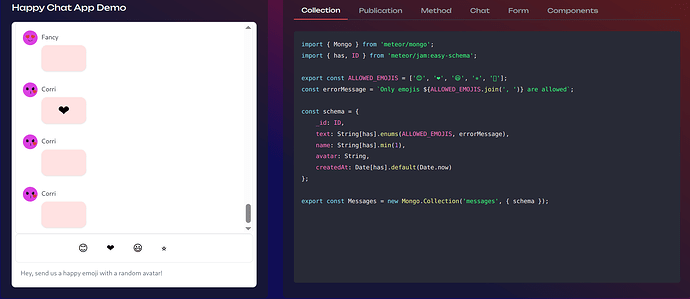A New Era, A New Identity
First things first! We’re introducing fresh new brands for both Meteor and Galaxy.
Our new Meteor brand represents our commitment to modern JavaScript. The redesigned Meteor website is ready and includes a cool interactive demo showcasing what Meteor can do.
Meanwhile, Galaxy’s new independent brand shows it’s growing beyond its Meteor-only roots into a robust, multi-stack cloud platform.
Meteor 3: Embracing the Node.js Ecosystem
After countless nights, we released Meteor 3.0 in July 2024 (now we’re at version 3.2). This release wasn’t just another version bump. It shows where we want to go in the future.
These changes help Meteor work better with other Node.js tools. This is important because we can use the best tools in the JavaScript ecosystem instead of maintaining our solutions for everything.
What’s Coming in 2025
Our 2025 roadmap shows where we’re heading.
Bundle Optimization: Our Current Priority
- Working with modern bundlers: We’re making it easy to use RSPack, ESBuild, and/or Rollup
- Faster builds: With our new tools added in version 3.2 and 3.3 beta
- Better development experience: Making changes to your code will show up more quickly
Upcoming Improvements
- Modernized RPC Methods and Publications: Adding self-documenting code, better validation, and more intuitive interfaces while maintaining backward compatibility
- MongoDB Change Streams: Using the official way to get real-time updates from MongoDB
- Better TypeScript support: Making it easier to use TypeScript with Meteor and its packages
- CapacitorJS for mobile apps: A better, newer way to build mobile apps
- Faster releases: Making our process quicker so you get updates sooner
Galaxy Expands Its Universe
Galaxy is evolving beyond its role as a Meteor-only hosting platform. The platform now supports Node.js and Python applications, including frameworks such as Express, Nest, Adonis, Flask, and Django.
Our promise is simple but powerful: We’ll provide the most user-friendly cloud platform and the most responsive support team.
Complete Platform with Database Solutions
In 2024, we enhanced Galaxy by adding MongoDB. We’re continuing this evolution in 2025 by expanding our database offerings to include PostgreSQL (coming soon), Redis, and FerretDB.
Galaxy now operates as an independent platform with its own dedicated website and distinct brand identity separate from Meteor.
Try It Today
I encourage you to upgrade to Meteor 3. You’ll feel the benefits of native async/await and modern Node.js features. Meteor 3.3, which is currently in beta, already brings faster builds.
For those working with Node.js, Python, and their popular frameworks, consider exploring Galaxy. Visit our new Galaxy website.
On our blog, you can read the full article.
